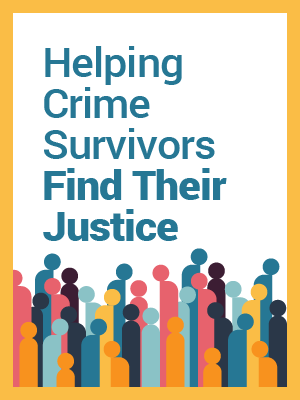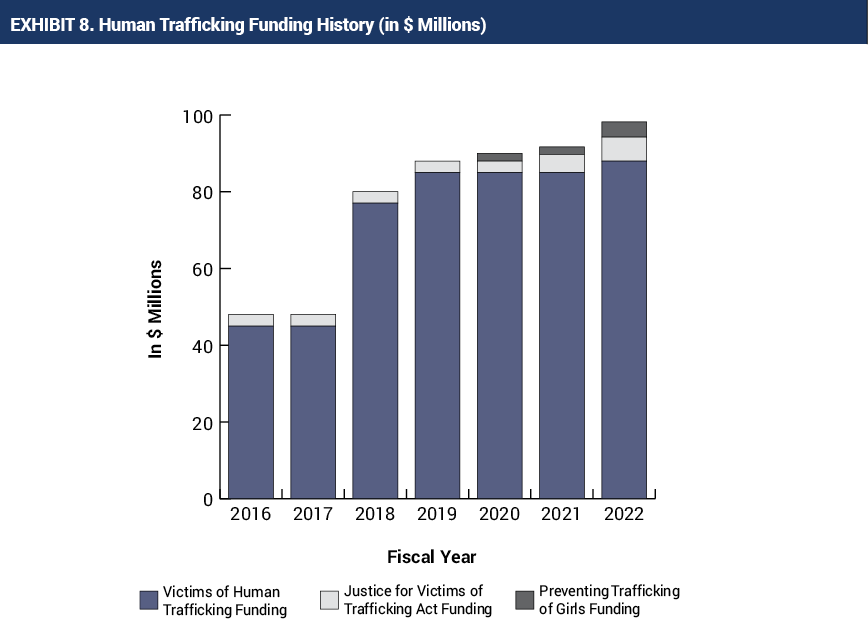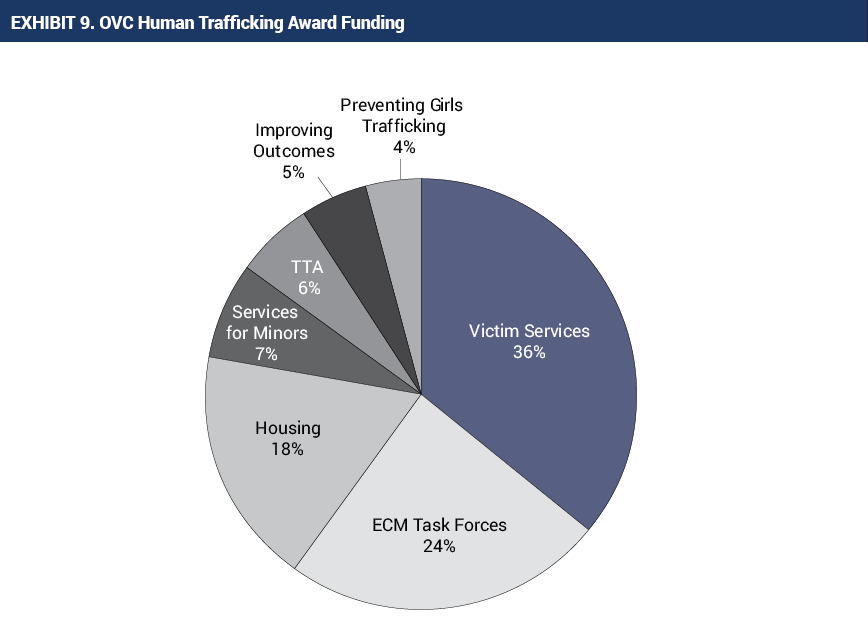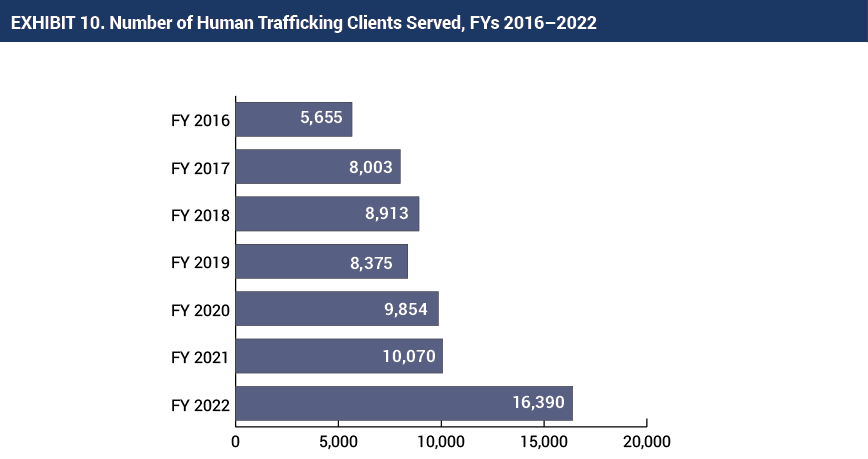Archival Notice
This is an archive page that is no longer being updated. It may contain outdated information and links may no longer function as originally intended.
Combating Human Trafficking
OVC administers the largest amount of federal funding dedicated to responding to human trafficking in the United States.
OVC funding supports the delivery of direct services such as case management, housing, legal assistance, and employment; multidisciplinary collaboration; and state-level approaches to identifying and serving victims of human trafficking.
In addition, OVC manages a broad array of training and technical assistance (TTA) for victim service providers, law enforcement, and allied professionals, with a focus on enhancing the quality and quantity of services available to trafficking victims and building the capacity of justice professionals to identify victims and bring their traffickers to justice. To enhance anti-trafficking programming and policies, OVC engages in ongoing interagency and intra-agency collaboration and seeks out opportunities to learn from survivors, service providers, and other frontline stakeholders throughout the country.
OVC’s anti-trafficking funding has increased significantly over the past 7 years, which has allowed OVC to intensify its efforts on behalf of trafficking victims, announce new initiatives, and expand existing programs (see exhibit 8). At the close of FY 2022, OVC was managing more than 500 anti-trafficking awards representing over $361 million.
Roughly 75 percent of OVC anti-trafficking funding goes to direct victim services for human trafficking victims, with some of that funding specifically for housing services and services for minor victims of sex and labor trafficking (see exhibit 9).
New in FY 2022 was funding for the Field-Generated Strategies to Address the Criminalization of Minor Victims of Sex Trafficking program, recognizing that for a variety of reasons related to their trafficking, youth who are victims of sex trafficking are being arrested, detained, and confined in many jurisdictions. There is no one model or solution to this problem as jurisdictions have different needs, service options, and challenges, so this funding opportunity allowed applicants to propose activities that would best address the needs of minor victims of sex trafficking in their jurisdictions and prevent further involvement in the justice system.
Additionally, a fourth of OVC funding goes to Enhanced Collaborative Model (ECM) Task Forces to support multidisciplinary teams of law enforcement agencies, prosecutors, and victim service organizations in implementing collaborative, victim-centered, and trauma-informed approaches to identifying and serving victims of all types of human trafficking. The remaining funding supports—
- work at the jurisdictional level to encourage states and Tribes to develop, enhance, and coordinate programs and activities to improve outcomes for child and youth victims of sex and labor trafficking.
- efforts focused on trafficking prevention for girls at risk for trafficking.
- the provision of training and technical assistance and the development of tools and resources to assist service providers and the anti-human trafficking field in ensuring successful outcomes for survivors of human trafficking.
From July 1, 2021, through June 30, 2022, OVC grantees providing direct services to trafficking victims across the country reported 5,620 new clients and 10,770 existing clients from previous reporting periods who required ongoing services. The 16,390 total clients represent an increase from the 10,070 clients reported by OVC grantees in the previous 12 months (see exhibit 10). This reflects the work of 192 grantee organizations implementing FY 2019 and prior awards. For that same period, OVC grantees implementing victim assistance programs reported conducting 1,967 trainings and training 68,058 professionals representing schools and educational institutions, medical and public health providers, victim-service providers, social-service providers, and state and local law enforcement agencies.
Furthermore, in FY 2021 and 2022, ECM task forces opened 8,757 new sex trafficking investigations, 490 new labor trafficking investigations, and 477 new sex and labor trafficking investigations. These new investigations identified 7,957 potential victims of sex trafficking, 9,334 potential victims of labor trafficking, and 560 potential victims of both sex and labor trafficking. The task forces were able to secure 3,788 arrests for sex trafficking, 31 arrests for labor trafficking, and 164 arrests for sex and labor trafficking.
Charges were filed against 1,949 individuals in sex trafficking cases, 38 individuals in labor trafficking cases, and 31 individuals in both sex and labor trafficking cases. The task forces secured plea bargains, guilty pleas, and guilty by trial pleas in 630 sex trafficking cases, 16 labor trafficking cases, and 4 sex and labor trafficking cases. A total of 12,351 individuals were identified as confirmed trafficking victims—the majority being victims of sex trafficking (9,003)—ranging from ages 13 and younger to 60 years and older.
Developing Standards of Care for Anti-Trafficking Service Providers
Survivors of human trafficking have diverse needs and may receive assistance from a host of organizations that have varying degrees of experience and expertise.
As such, OVC is partnering with the U.S. Department of Health and Human Services’ Office on Trafficking in Persons (OTIP) to fund the development of standards of care (SOC) for anti-trafficking service providers to promote uniform service standards that will ensure consistent quality of care and reduce potential harm to trafficking survivors. In September 2022, OVC competitively awarded $1.2 million to Freedom Network USA to develop the SOC, working closely with OVC, OTIP, and a diverse group of stakeholders and survivors with lived experience.
The SOC will address all levels of victim service responses to adult and minor survivors of sex and labor trafficking rendered by service delivery organizations funded by OVC and OTIP, and other service providers who do not receive that funding. The SOC will contemplate a comprehensive array of direct services, including case management, housing, legal, behavioral health, economic empowerment, and other services.
Investing in TTA
Through its cadre of anti-trafficking TTA providers, OVC provides practitioner-driven, evidence-based TTA that is responsive to the particular needs of victim service providers and system stakeholders, their communities, and the victims they serve. At the close of FY 2022, OVC was supporting 18 grants, cooperative agreements, and contracts that strengthen victim assistance responses to human trafficking (by offering housing, employment, legal services, and responses to labor trafficking) and support multidisciplinary task forces as they build capacity and leadership in identifying human trafficking victims; connecting them to services; and bringing their traffickers to justice. In FYs 2021 and 2022, OVC awarded $11.2 million in TTA grants and contracts. OVC TTA providers delivered a wide variety of TTA to help OVC grantees and the field respond to the needs of human trafficking survivors. Some examples are listed below:
- In FY 2022, Freedom Networks' Housing Training and Technical Assistance Project released Building Trauma-Informed Practices for Anti-Trafficking Housing Programs, a toolkit that provides a framework for anti-trafficking providers offering housing services to use as they build trauma-informed, person-centered, and voluntary housing programs for trafficking survivors.
- Since the launch of the OVC-funded Promoting Employment Opportunities for Survivors of Trafficking project, Futures Without Violence has provided training and technical assistance to more than 4,100 providers; developed 12 local victim service/workforce development/employer collaborations across 10 cities and states; supported the development and expansion of economic empowerment services at 155 victim service agencies; and hosted 45 trainings and peer learning events for victim service providers and workforce programs.
- In FY 2021, the Human Trafficking Capacity Building Center launched the Talking Circle series, convening American Indian and Alaska Native panelists to discuss topics related to human trafficking. In FY 2022, registrants came from 50 states (plus the District of Columbia) and 2 territories, representing at least 28 (plus the District of Columbia and Canada) Tribal communities. The Talking Circle’s broad reach exposed participants to information about serving AI/AN victims of human trafficking in underserved areas, emphasizing culture as an integral part of healing services.
- The International Association of Chiefs of Police launched Task Force Connect, an online community that promotes peer-to-peer learning opportunities for OVC-funded ECM Human Trafficking Task Force members to share resources and information, and to connect with other professionals who are dedicated to combating human trafficking.
- During the 2021–2022 school year, the National White Collar Crime Center (NW3C) delivered the TraffickSTOP program―a human trafficking identification and prevention curriculum for high school students―in three pilot schools. NW3C partnered with the International Association of Chiefs of Police and the National Association of School Resource Officers to develop the curriculum, materials, and resources.
- As of August 2022, the Human Trafficking Collective (HTC) provided training and technical assistance to more than 19,000 anti-trafficking stakeholders and collaborated with hundreds of lived experience experts to provide trauma-informed and survivor-led expertise while setting the precedent that partnerships with survivors must be elevated and central in anti-trafficking efforts. Additionally, more than 29,000 individuals completed the Understanding Human Trafficking online training course developed by HTC and the OVC Training and Technical Assistance Center with funding from OVC.
- In 2021, RTI International released Improving Outcomes for Child and Youth Victims of Human Trafficking: Compendium of Resources, a compilation of resources developed by OVC Improving Outcomes for Child and Youth Victims of Human Trafficking (Improving Outcomes) grantees, funded from 2016 through 2019. These materials were designed by grantees as part of their Improving Outcomes projects to improve the identification of and coordinated response to child and youth victims of human trafficking within their states.
- In FY 2022, Youth Collaboratory released two videos, in a three-part series, on emerging trends and promising practices for prevention and early intervention for Black girls who are at risk of, or are experiencing, sex trafficking—Combating and Preventing Sex Trafficking of Black Girls: Promising Practices (Part 1) and The Intersection of Juvenile Justice and the Sex Trafficking of Black Girls (Part 2).
For additional information, please visit OVC’s anti-human trafficking initiatives website.







